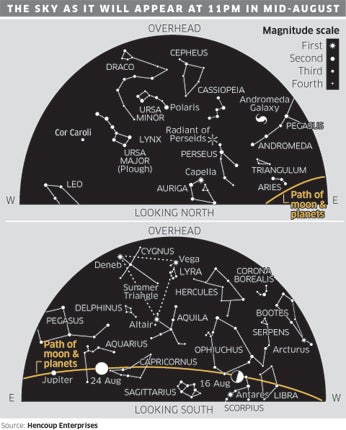The Stars: August

In 1974, Frank Drake, director of the Arecibo Observatory in Puerto Rico, had completed the task of resurfacing the world's biggest radio telescope. This enormous dish, 300 metres across, was now the most powerful on Earth. How to celebrate its switch-on?
His PA had the bright idea: "Use the telescope in reverse to beam a message about life on Earth to the stars." Drake's team worked on a coded message, a series on on-off pulses. It was beamed towards M13, a globular cluster of stars in the rather obscure constellation of Hercules. This dense ball of stars, which looks like a swarm of bees, lies 25,000 light years away. So if ET hears the message and picks up the phone, we can expect a reply in about 50,000 years!
Globular clusters are the oldest denizens of our Galaxy. They form an outer "scaffold" surrounding the Milky Way, each containing thousands – sometimes hundreds of thousands – of ancient red stars. Most globulars are only visible through binoculars or a telescope. M13 is a rare exception: on a clear night you can glimpse it with the naked eye, as a small fuzzy patch of light. Hercules is home to another globular cluster, M92, not far from M13.
What's Up
We have our own earthbound fireworks in November, and the French and Americans theirs in July, but the sky puts on its best display of pyrotechnics in August. This year the show will be especially spectacular as that light-polluting spoilsport, the Moon, is below the horizon. Any time in the first three weeks of the month, you may spot a shooting star zipping across the sky from the constellation Perseus. The show reaches a crescendo on the night of 12-13 August, when we may be treated to a meteor every minute or two. These shooting stars are specks of cosmic dirt shed by Comet Swift-Tuttle as it traipses around the solar system, and burn up as they hit the Earth's atmosphere. The dust motes are travelling in parallel paths, but perspective makes them seem to spread out from a point in Perseus (see chart).
The first three weeks of August also treat us to a planetary dance, low in the West after sunset. The leader is brilliant Venus, and at the start of the month the fainter planets Mars and Saturn lie to its upper left. The slender crescent Moon joins the planetary frolic on 12 and 13 August.
Later in the evening, giant planet Jupiter dominates the eastern skies, shining among the dull stars below the flying horse, Pegasus. High in the south you'll find the Summer Triangle, its corners marked by the bright stars Deneb, Altair and Vega. Down on the southern horizon, look out for orange-red Antares, marking the heart of the scorpion, Scorpius. And to its left lies the celestial archer, Sagittarius – which to our eyes looks far more like a teapot!
Diary
3: 5.58 am Moon at Last Quarter
7: Mercury at greatest elongation east
10: 4.08 am New Moon
12/13: Maximum of Perseid meteor shower
16: 7.14 pm Moon at First Quarter
20: Venus at greatest elongation east
24: 6.04 pm Full Moon
Subscribe to Independent Premium to bookmark this article
Want to bookmark your favourite articles and stories to read or reference later? Start your Independent Premium subscription today.

Join our commenting forum
Join thought-provoking conversations, follow other Independent readers and see their replies